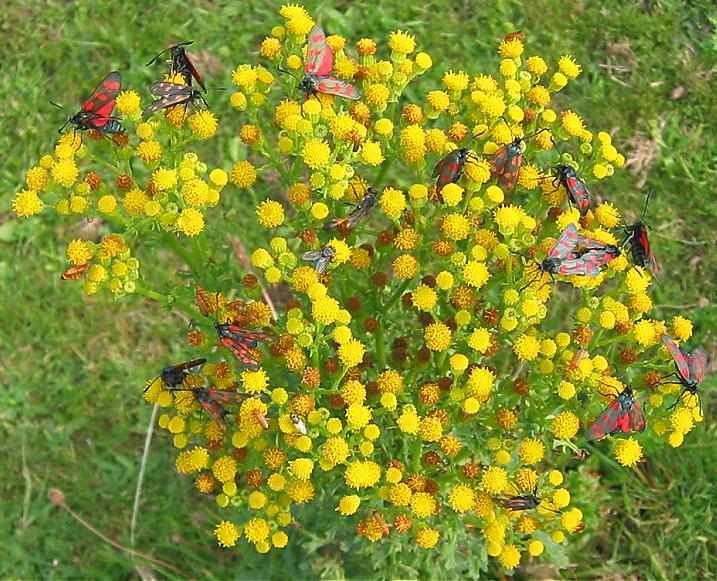
Duinkruiskruid - Dune ragwort - Jacobaea vulgaris ssp. dunensis (Compositae)
(syn. Senecio dunensis; Senecio jacobaea var. flosculosus)
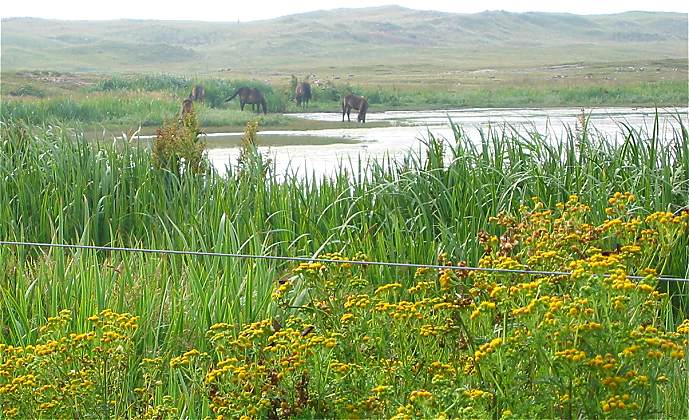
|
In de duinen, o.a. op Texel, groeit Duinkruiskruid, een andere variant van Jakobskruiskruid, zonder straalbloemen. In de nieuwe flora van Heukels (23ste druk, eind 2005)
heeft men deze ondersoort dunensis genoemd. Hierboven een rijke populatie, met erachter paarden die het hopelijk nooit in hun maaltijd zullen krijgen. |
In the dunes, a.o. on the island of Texel, a subspecies of Common ragwort is found without ray-florets. In the new Heukels Flora of the plants in the Netherlands
(23th edition, end 2005) this plant has been given the name of ssp. dunensis. Above a dense population, it's to be hoped for these horses behind it won't ever get it to eat with their hay. |
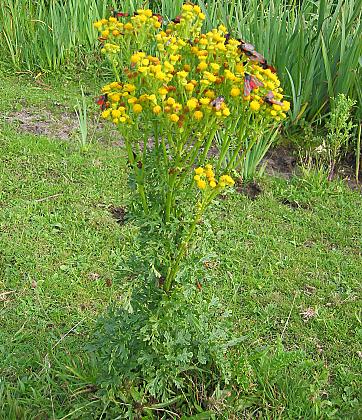 | Een apart staande plant, vol vlinders (dezelfde als bovenaan de pagina). De bouw en de bladeren zijn
gelijk aan die van gewoon Jakobskruiskruid. De bladeren aan de voet van de plant (zie ook foto hieronder) zijn nog mooi groen, ondanks de bloei; van Jakobskruiskruid wordt gezegd dat de bladeren onderaan de plant meestal verdord zijn tegen dat de plant bloeit. Dat is mij echter nooit opgevallen. A single plant, full of moths (the same one as at the top of this page). Build and foliage of the plant are similar to those of Common ragwort. The leaves at the foot of the plant (see below) are still fresh and green, in spite of the bloom; it is said that the lower leaves on Common ragwort are mostly brown when the plant comes into flower. However, I never noticed that. |
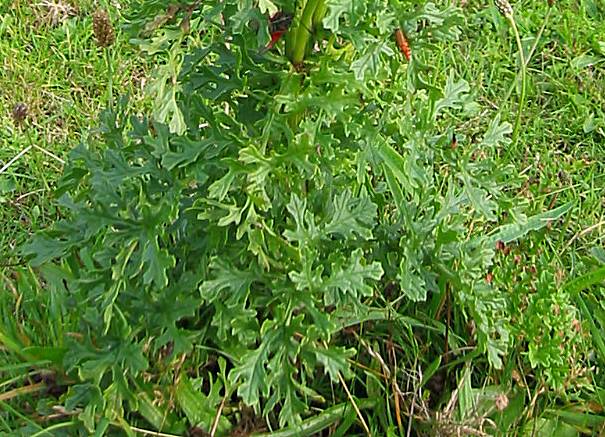
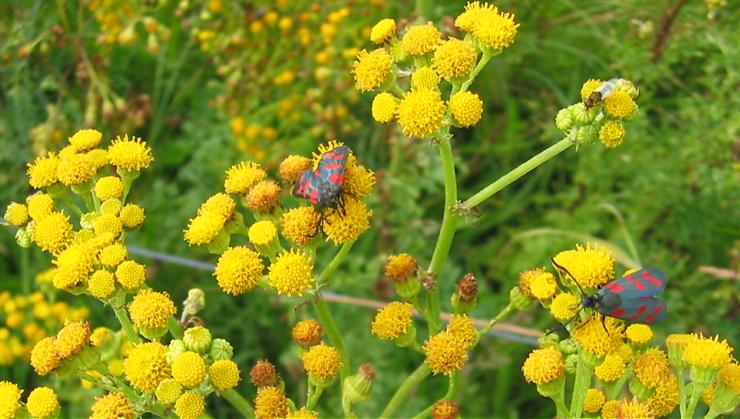
| Detail van de planten op Texel. Deze hebben geen straalbloemen nodig om insecten te lokken, dat is wel duidelijk. Heel veel zwart-met-rode Sint-Jansvlinders (Zygaena filipendulae) zaten op de bloemen, maar ook andere vlinders, torretjes en haantjes. Aanvankelijk dacht ik dat bovengenoemde soort Sint-Jakobsvlinders waren (logisch gedacht, en deze lijkt er qua kleur ook heel veel op), maar die schitterden door afwezigheid. De gestreepte rupsen van die soort voeden zich nl. met Jakobskruiskruid (Jacobaea vulgaris ssp. vulgaris) en andere kruiskruiden zoals Klein kruiskruid (Senecio vulgaris) - zie onderste foto - maar die van de Sint-Jansvlinder eten klaversoorten. Deze vlinder komt echter veel voor in duingebieden zoals op Texel. | These plants on the island of Texel don't need ray-florets do draw the attention of insects, that's clear. A great many black-and-red 6-spot Burnets (Zygaena filipendulae) moved around on the flowers, but also other moths, butterflies and beetles. At first I thought above-mentioned were Cinnabar moths (Tyria jacobaeae), which was a logical idea because these have the same colours and their striped caterpillars feed on Common ragwort (Jacobaea vulgaris ssp. vulgaris) and other ragworts, e.g. Groundsel (Senecio vulgaris) - see bottom picture - but those of the 6-spot Burnet live on clover varieties, quite a different type of hostplant. This moth is very common in coastal areas with dunes, like on the island of Texel. |
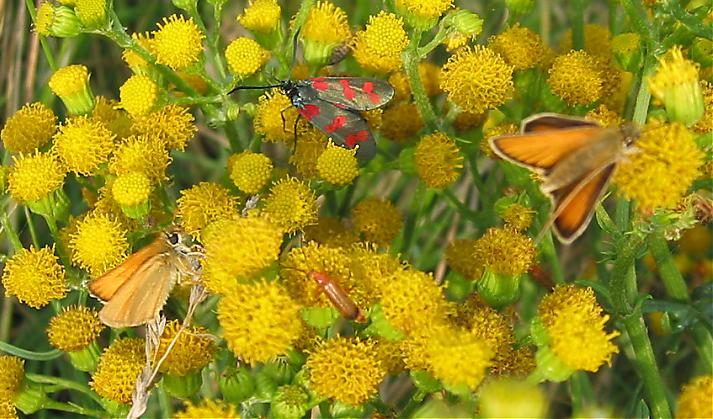
Kruiskruiden zijn giftig voor zoogdieren, maar ook voor sommige insecten. Deze kunnen er vast wel tegen!
Ragworts are poisonous to mammals, and some insects too. I suppose it won't do any harm to all these...
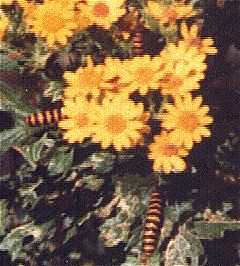
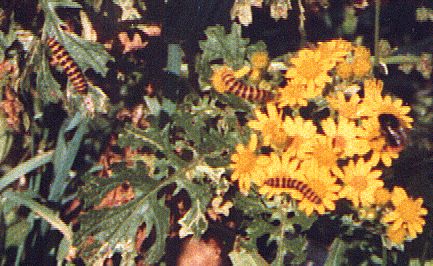
| Zebrarupsen van Sint Jakobsvlinder (Tyria jacobaeae) op een foto uit 1975 (Guernsey). Hoewel ook aan zee, hebben de planten daar wel straalbloemen. | Striped caterpillars of Cinnabar moth (Tyria jacobaeae) in 1975 on Guernsey. Though also by the seaside, the flowers do have ray-florets there. |
.jpg)
Dezelfde soort rups, één enkele op een nietig Klein kruiskruidplantje in de duinen bij Callantsoog (2005).
The same sort of caterpillar, only one on a tiny groundsel plant on the beach at Callantsoog (2005).
Kruiskruiden-pagina / Ragwort page
Alarmerende krantenartikelen uit 2004 en 2005

